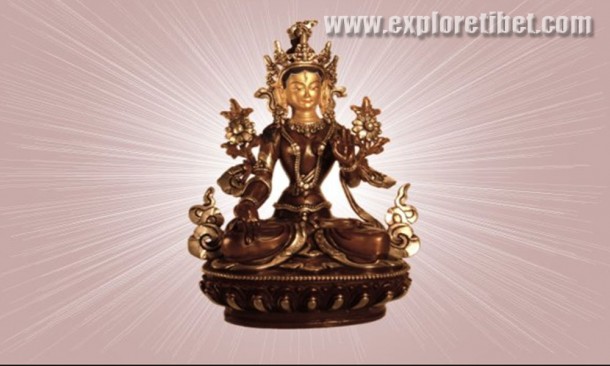Magnificent God-Dolma ( Tara).

Dolma ( Tara)
There are innumerable manifestations of Tara, as many as beings require bringing protection, long life and peace, overcoming obstacles and saving beings from ill wills.Tara is one of the most beloved of deities, particularly by Tibetans. In Buddhism, Tara (Sanskrit, “star”) is a Buddhist savior-goddess especially popular in Tibet. Legend has it that once, many eons ago during the time of Buddha Dundubhisvara, there lived a princess by the name of ‘Moon of Wisdom-knowledge’. She was a very devoted disciple and would daily set out many offerings to the Buddha and his sangha. Eventually she generated bodhicitta, the aspiration to attain enlightenment and become a Buddha herself, in order to help all living beings. Some bhikshus came to know about this, and urged her to dedicate the merits she had created to be reborn as a male. However, the princess rejected this advice, saying:Here there is no man, there is no woman, no self, no person, and no consciousness. Labelling “male” or “female” has no essence but deceives the evil-minded world.
She went on to make the following vow:
“There are many who desire enlightenment in a man’s body, but none who work for the benefit of sentient beings in the body of a woman. Therefore, until samsara is empty, I shall work for the benefit of sentient beings in a woman’s body.”
Tara has 21 primary emanations, each of which performs different activities such as pacification, increase and so forth. The different colours of these 21 Taras correspond to the 4 different types of enlightened activity.
“Tara is the female Buddha of enlightened activity, of which there are 4 types: pacifying, increasing, overpowering and wrathful. Each of these is represented by a different color:
- White represents the enlightened activity of pacifying, for example overcoming sickness, causes of untimely death and obstacles to success in one’s life or one’s practice.
- Yellow represents the enlightened activity of increasing the positive qualities conducive to a long life, peace, happiness and success in one’s Dharma practice.
- Red represents the enlightened activity of power, or overpowering external forces that cannot be tamed through the first two activities,
- for example, removing obstacles to sickness, untimely death, etc., and forcefully accumulating conducive conditions for one’s Dharma practice.
- Black represents the enlightened activity of wrath, which involves using forceful methods for accomplishing activities for enlightened purposes that cannot be accomplished through other means.”
It is the goddess Tara who helps us to remain “centered”. The myths of the Goddess Tara remind us of our “oneness” with all of creation and the importance of nurturing the spirit within.
Recent Posts
The Perfect Tibet Tour Package
Journey to Tibet
Exploring Tibet
All Categories
- About Tibet
- book a Tibet tour
- Buddhism Practice
- Budget Tour
- China-Tibet Train
- Customized Tibet tour
- Historical Sites
- Hot Springs in Tibet
- News
- Photography in Tibet
- Tibet attraction
- Tibet Group Visa
- Tibet Motorcycle Tour
- Tibet Small Group Tours
- Tibet Tours and Tibetan Tour Guide
- Tibet Train
- Tibet Travel FAQs
- Tibet Travel Information
- Tibet Travel News
- Tibet Travel Permit Update
- Tibet Travel Prices Rises
- Tibet Trek
- Tibet Trekking Tour
- Tibet weather and climate
- Tibet Wildlife animals
- Tibet Winter Tour
- Tibetan Buddhism
- Tibetan Cultural Features
- Tibetan Culture and Poeple
- Tibetan Festivals
- What to see in Tibet



